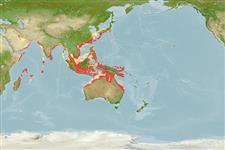Common names from other countries
Environment: milieu / climate zone / depth range / distribution range
Ecologia
marinhas; estuarina demersal; intervalo de profundidade 0 - 60 m (Ref. 9804). Tropical; 20°C - 30°C (Ref. 13614); 37°N - 28°S, 48°E - 154°E
Indo-West Pacific: Red Sea (Ref. 130655), the Persian Gulf, Gulf of Oman, Arabian Sea, Bay of Bengal, and Japan (north to central Honshu), China, South China Sea including Gulf of Thailand, Indonesia, northern Australia.
Tamanho / Peso / Idade
Maturity: Lm ? range ? - ? cm
Max length : 30.0 cm TL macho/indeterminado; (Ref. 9804); common length : 25.0 cm TL macho/indeterminado; (Ref. 3540)
Spiny dorsal-fin membrane very dark between first and third spines, and usually equally dark between third and fifth spines. Outline of head from base of first dorsal-fin spine to above eye an even slightly convex curve or almost a straight line (Ref 9804).
Inhabits sandy or muddy flat in coastal and estuarine waters. Feeds on benthic invertebrates. Sold fresh in markets. Used in Chinese medicine (Ref. 12166). Minimum depth range from Ref. 121772.
Ciclo de vida ou comportamento de acasalamento
Maturities | Reprodução | Spawnings | Egg(s) | Fecundities | Larvas
Matsuura, K., 2001. Triacanthidae. Triplespines. p. 3905-3910. In K.E. Carpenter and V. Niem (eds.) FAO species identification guide for fishery purposes. The living marine resources of the Western Central Pacific. Vol. 6. Bony fishes part 4 (Labridae to Latimeriidae), estuarine crocodiles. FAO, Rome. (Ref. 9804)
Status na Lista Vermelha da UICN (Ref. 130435)
CITES (Ref. 128078)
Not Evaluated
Ameaça para os humanos
Harmless
Uso pelos humanos
Pescarias: pouco comercial
Ferramentas
Relatórios especiais
Baixar XML
Fontes da internet
Estimates based on models
Preferred temperature (Ref.
115969): 24.6 - 29.1, mean 28.2 (based on 1448 cells).
Índice de diversidade filogenética (Ref.
82804): PD
50 = 0.7578 [Uniqueness, from 0.5 = low to 2.0 = high].
Bayesian length-weight: a=0.01072 (0.00523 - 0.02196), b=2.87 (2.68 - 3.06), in cm Total Length, based on LWR estimates for this species & (Sub)family-body (Ref.
93245).
Nível Trófico (Ref.
69278): 2.8 ±0.29 se; based on food items.
Resiliência (Ref.
120179): médio(a), tempo mínimo de duplicação da população 1,4 - 4,4 anos (K=0.22).
Fishing Vulnerability (Ref.
59153): Moderate vulnerability (40 of 100).
